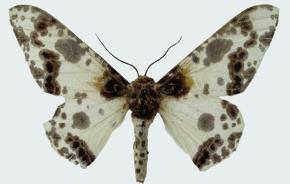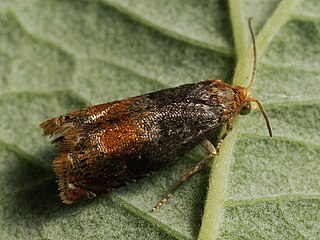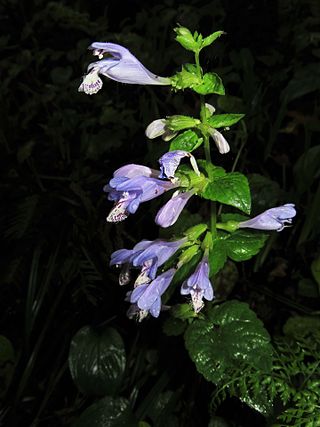
Indocalamus is a genus of about 35 species of flowering plants in the grass family (Poaceae), native to China, Vietnam and Japan. They are quite small evergreen bamboos normally up to 2 m (6.6 ft) in height, initially forming clumps and then spreading to form larger thickets. They have thick, glossy leaves. Ruo leaves use to wrap foods like rice during dragon boat festival, originate in fujian refer to Indocalamus longiauritusoriginally but now are nonspecific to just about any leaf wrap.

Adenophora is a genus of flowering plants in the family Campanulaceae, the bellflowers. Plants of this genus are known commonly as ladybells. Most of the species in the genus are native to eastern Asia, with a few in Europe. Many are endemic to either China or Siberia.

The peach blossom is a moth of the family Drepanidae. It was first described by Carl Linnaeus in his 1758 10th edition of Systema Naturae.

The genus Helwingia consists of shrubs or rarely small trees native to eastern Asia, the Himalayas, and northern Indochina. It is the only genus in the family Helwingiaceae.

Notocelia rosaecolana is a moth of the family Tortricidae. It is found in the Palearctic realm, where it has been recorded from China, Mongolia, Korea, Japan, Iran, Central Asia, Russia and Europe.

Gravitarmata margarotana, the pine cone tortrix or pine twig moth, is a moth of the family Tortricidae. In Europe, it is found from England to Austria and Poland, east to the Baltic region to Russia, China, Korea and Japan.

Rhopobota naevana, the holly tortrix moth, holly leaf tier or blackheaded fireworm, is a moth of the family Tortricidae. It is found from Europe to eastern Russia, China, Taiwan, Mongolia, Korea and Japan. It is also present in India, Sri Lanka and North America.

Biston panterinaria is a moth of the family Geometridae. It is found in China, India, Nepal, Sikkim, Vietnam and Thailand.
Megaherpystis melanoneura is a moth of the family Tortricidae. It is found in Japan, Korea, China, Taiwan, Thailand, India and Vietnam.

Tethea consimilis is a species of moth of the family Drepanidae first described by Warren in 1912. It is found in Asia, including the Russian Far East, Japan, Korea, Taiwan, Myanmar, Indonesia and India. The habitat consists of various types of mixed and broad-leaved forests.
Eupoecilia amphimnesta is a species of moth of the family Tortricidae. It is found in China, Taiwan, India, Japan, Korea, Mongolia, Russia and Europe.

Spilarctia subcarnea is a moth in the family Erebidae. It was described by Francis Walker in 1855. It is found in Nepal, China, the Russian Far East, Korea, Japan and Taiwan.
Notocelia autolitha is a species of moth of the family Tortricidae. It is found in China, Korea and Japan.

Epinotia bicolor is a species of moth of the family Tortricidae. It is found in China, Taiwan, Korea, Japan, Vietnam and India.

Lepteucosma huebneriana is a species of moth of the family Tortricidae. It is found in China, Korea, Japan, Russia and Europe, where it has been recorded from France, Liechtenstein, Germany, Austria, Switzerland, Italy, the Czech Republic, Slovakia, Slovenia, Hungary, Romania, Latvia and Lithuania.
Spilonota albicana, the white fruit moth, larger apple fruit moth or eye-spotted bud moth, is a species of moth of the family Tortricidae. It is found in China, Korea, Japan and Russia. It has been accidentally introduced in the Netherlands.

Meehania is a genus of flowering plants in the family Lamiaceae, first described in 1894. It is native to China, Japan, and the eastern United States.
- Meehania cordata(Nutt.) Britton - Appalachian Mountains of eastern United States
- Meehania faberi(Hemsl.) C.Y.Wu - Gansu, Sichuan
- Meehania fargesii(H.Lév.) C.Y.Wu - Guangdong, Guangxi, Guizhou, Hubei, Hunan, Jiangxi, Sichuan, Yunnan, Zhejiang
- Meehania henryi(Hemsl.) Y.Z.Sun ex C.Y.Wu - Guizhou, Hubei, Hunan, Sichuan
- Meehania montis-koyaeOhwi - Honshu, Fujian, Zhejiang
- Meehania pinfaensis(H.Lév.) Y.Z.Sun ex C.Y.Wu - Guizhou
- Meehania urticifolia(Miq.) Makino - Japan, Korea, Russian Far East, Jilin, Liaoning

Mosla is a genus of plants in the family Lamiaceae, first described as a genus in 1875. It is native to eastern Asia, the Himalayas, and southeastern Asia.
- Mosla bracteataDoan ex Suddee & A.J.Paton - Vietnam
- Mosla cavalerieiH.Lév.- Vietnam, Guangdong, Guangxi, Guizhou, Hubei, Jiangxi, Sichuan, Yunnan, Zhejiang
- Mosla chinensisMaxim. - Vietnam, Korea, Japan, Anhui, Fujian, Guangdong, Guangxi, Guizhou, Hubei, Hunan, Jiangsu, Jiangxi, Shandong, Sichuan, Taiwan, Zhejiang
- Mosla coreanaH.Lév. - Korea
- Mosla dianthera(Buch.-Ham. ex Roxb.) Maxim. - China, Japan, Korea, Ryukyu Islands, Kuril Islands, Primorye, Caucasus, Himalayas, Myanmar, Vietnam, Philippines, Sumatra
- Mosla exfoliata(C.Y.Wu) C.Y.Wu & H.W.Li - Sichuan
- Mosla hangchouensisMatsuda - Zhejiang
- Mosla japonica(Benth. ex Oliv.) Maxim. - Japan, Korea, Ryukyu Islands
- Mosla longibracteata(C.Y.Wu & S.J.Hsuan) C.Y.Wu & H.W.Li - Guangxi, Zhejiang
- Mosla longispica(C.Y.Wu) C.Y.Wu & H.W.Li - Jiangxi
- Mosla pauciflora(C.Y.Wu) C.Y.Wu & H.W.Li - Guizhou, Hubei, Sichuan
- Mosla punctulataNakai - Korea, Taiwan, Japan, China
- Mosla scabra(Thunb.) C.Y.Wu & H.W.Li - Vietnam, Korea, Japan, Ryukyu Islands, Anhui, Fujian, Gansu, Guangdong, Guangxi, Henan, Hubei, Hunan, Jiangsu, Jiangxi, Liaoning, Shaanxi, Sichuan, Taiwan, Zhejiang
- Mosla soochouensisMatsuda - Anhui, Jiangsu, Jiangxi, Zhejiang
- Mosla tamdaoensisPhuong - Vietnam












